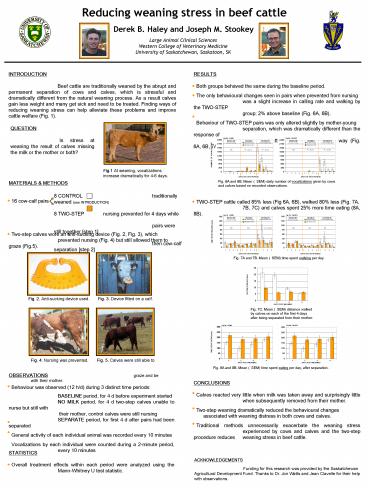Reducing weaning stress in beef cattle PowerPoint PPT Presentation
1 / 1
Title: Reducing weaning stress in beef cattle
1
Reducing weaning stress in beef cattle
Derek B. Haley and Joseph M. Stookey
Large Animal Clinical Sciences Western College of
Veterinary Medicine University of Saskatchewan,
Saskatoon, SK
INTRODUCTION Beef cattle are traditionally
weaned by the abrupt and permanent separation of
cows and calves, which is stressful and
dramatically different from the natural weaning
process. As a result calves gain less weight and
many get sick and need to be treated. Finding
ways of reducing weaning stress can help
alleviate these problems and improve cattle
welfare (Fig. 1).
RESULTS Both groups behaved the same during
the baseline period. The only behavioural
changes seen in pairs when prevented from
nursing was a slight increase in calling rate
and walking by the TWO-STEP group 2 above
baseline (Fig. 6A, 6B). Behaviour of TWO-STEP
pairs was only altered slightly by mother-young
separation, which was dramatically different
than the response of CONTROL cattle weaned the
traditional way (Fig. 6A, 6B, 7A, 7B, 7C).
QUESTION Is stress at weaning the result of
calves missing the milk or the mother or both?
Fig. 6A - COWS
Fig. 6B - CALVES
BASELINE all calves nursing
NO MILK half calves nursing half calves no milk
SEPARATE cow and calf pairs apart
BASELINE all calves nursing
NO MILK half calves nursing half calves no milk
SEPARATE cow and calf pairs apart
NS
P lt 0.01
P lt 0.01
NS
P lt 0.01
P lt 0.01
NUMBER OF VOCALIZATIONS
Fig.1 At weaning, vocalizations increase
dramatically for 4-6 days.
1 2 3 4 1
2 3 4 1
2 3 4
1 2 3 4 1
2 3 4 1
2 3 4
DAYS OF EACH PERIOD
DAYS OF EACH PERIOD
Fig. 6A and 6B. Mean (SEM) daily number of
vocalizations given by cows and calves based on
recorded observations.
- MATERIALS METHODS
- 16 cow-calf pairs
- Two-step calves wore an anti-sucking device
(Fig. 2, Fig. 3), which prevented nursing (Fig.
4) but still allowed them to graze (Fig.5).
8 CONTROL traditionally weaned (see
INTRODUCTION) 8 TWO-STEP nursing prevented for
4 days while pairs were still together step
1 then cow-calf separation step 2
TWO-STEP cattle called 85 less (Fig 6A, 6B),
walked 80 less (Fig. 7A, 7B, 7C) and calves
spent 25 more time eating (8A, 8B).
Fig. 7A - COWS
Fig. 7B - CALVES
BASELINE all calves nursing
NO MILK half calves nursing half calves no milk
SEPARATE cow and calf pairs apart
BASELINE all calves nursing
NO MILK half calves nursing half calves no milk
SEPARATE cow and calf pairs apart
Fig. 7A - COWS
NS
NS
NS
P lt 0.03
NS
NS
TIME SPENT WALKING (min)
1 2 3 4 1
2 3 4 1
2 3 4
1 2 3 4 1
2 3 4 1
2 3 4
DAYS OF EACH PERIOD
DAYS OF EACH PERIOD
Fig. 7A and 7B. Mean (SEM) time spent walking
per day.
DISTANCE WALKED (km)
Fig. 2. Anti-sucking device used. Fig. 3.
Device fitted on a calf.
1 2
3 4
DAYS POST WEANING
Fig. 7C. Mean (SEM) distance walked by calves on
each of the first 4 days after being separated
from their mother.
Fig. 8B - CALVES
Fig. 8A - COWS
TIME SPENT EATING (min)
Fig. 4. Nursing was prevented. Fig. 5.
Calves were still able to graze and be
with their mother.
1 2
3 4
DAYS POST WEANING
1 2
3 4
DAYS POST WEANING
Fig. 8A and 8B. Mean (SEM) time spent eating per
day, after separation.
OBSERVATIONS Behaviour was observed (12 h/d)
during 3 distinct time periods BASELINE
period, for 4 d before experiment started NO
MILK period, for 4 d two-step calves unable to
nurse but still with their mother, control
calves were still nursing SEPARATE period, for
first 4 d after pairs had been separated
General activity of each individual animal was
recorded every 10 minutes Vocalizations by
each individual were counted during a 2-minute
period, every 10 minutes
CONCLUSIONS Calves reacted very little when
milk was taken away and surprisingly little when
subsequently removed from their mother.
Two-step weaning dramatically reduced the
behavioural changes associated with
weaning distress in both cows and calves.
Traditional methods unnecessarily exacerbate the
weaning stress experienced by cows and calves
and the two-step procedure reduces weaning
stress in beef cattle.
STATISTICS Overall treatment effects within
each period were analyzed using the Mann-Whitney
U test statistic.
ACKNOWLEDGEMENTS Funding for this research was
provided by the Saskatchewan Agricultural
Development Fund. Thanks to Dr. Jon Watts and
Jean Clavelle for their help with observations.

